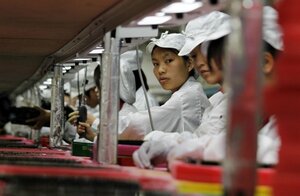Stop China’s plan to weaken American innovation
Opinion: China launched a systematic plan to replace all American technology companies with Chinese equivalents. US needs to tell China enough is enough.

Workers are seen inside a Foxconn factory in southern Guangdong province in China on May 26, 2010.
Bobby Yip/Reuters/File
China’s government is orchestrating a comprehensive effort to eradicate American competitors from its markets for information and communications technology (ICT) products and services. The intent is to hobble US companies competing in China, cultivate and promote China’s own domestic champions, and ultimately replace the US as the world’s ICT leader.
To achieve those goals, the Chinese are investing tens of billions of dollars to build up domestic production that can substitute for US imports in key industries such as semiconductors and software; fencing out US websites, applications, and other digital content platforms; forcing disclosure of proprietary intellectual property, technology, and source code; using anti-monopoly laws as a club to extract concessions from US companies; and even pressuring Chinese enterprises to stop using American-made hardware and software. Furthermore, China is utilizing a panoply of additional mercantilist measures that seek to unfairly advantage Chinese producers – from currency and standards manipulation to special benefits for state-owned enterprises.
To understand the context for these policies, you must first understand the evolution of Chinese economic policy over the past two decades. Up to the mid-2000s, China’s economic development strategy sought principally to induce foreign multinationals to shift production to China. In 2006, China pivoted to a “China Inc.” model of “indigenous innovation” which called for the nation to master 402 core technologies, from intelligent automobiles to integrated circuits and high-performance computers.
This shift essentially announced that Chinese economic strategy would now seek absolute advantage across virtually all advanced technology industries. It rejected the notion of comparative advantage, which holds that nations should specialize in the production of products or services at which they are the most efficient and trade for the rest. Instead, China wishes to dominate in production of both advanced technology products such as airplanes, semiconductors, and pharmaceuticals – plus commodity manufacturing. Ultimately, Chinese policymakers are trying to independently supply Chinese markets for advanced technology products with their own production while still benefitting from unfettered access to global markets for their technology exports.
In no sector is this strategy more apparent than in ICT. Here, China has used virtually every tool at its disposal to advantage domestic producers, including a vast array of mercantilist practices that are specifically designed to disadvantage American competitors.
For instance, the Chinese government has launched its “De-IOE” campaign to unabashedly pressure Chinese companies to replace products from IBM, Oracle, and EMC with Chinese-made alternatives. Cisco, Microsoft, and Qualcomm have meanwhile found themselves targeted for alleged violation of China’s anti-monopoly laws – though their only crime has been to innovate and use patents. China routinely blocks e-mail services, social media networks, digital content platforms, and Web-based productivity applications provided by American ICT firms such as Facebook, Google, and Microsoft. And China is investing more than $25 billion in an attempt to foster development of an indigenous semiconductor manufacturing industry to wrest market share from US competitors such as Intel, Qualcomm, and Texas Instruments. In January, China announced regulations that foreign-enterprise-developed ICT products and services be deemed “secure and controllable,” including having to undergo intrusive security testing, complying with Chinese national standards, and potentially disclosing valuable source code. And the government is considering new anti-terror laws requiring that tech companies turn over encryption keys to the government, which could make it difficult for US companies to do any business in China.
Put simply, China is pursuing not just a “De-IOE” strategy, but a blatant “De-USA” strategy, and this high-tech harassment will in all likelihood continue until China finally gets what it wants: the complete replacement in China of foreign technology companies with Chinese ones.
It is high time American policymakers recognize that China’s goal of replacing US-made advanced technology products with Chinese-made ones is a central component of China’s economic development strategy, and it won’t abate unless America makes clear that these policies are unacceptable and have costs and consequences.
To effectively confront the challenge posed by China’s state capitalism, the US government needs a “whole-of-government” approach that pursues a results-oriented trade strategy. This effort should be led by a new Office of Globalization Strategy in the office of the US Trade Representative (USTR) that thinks systemically about the design of US trade policy in the context of globalization and US competitiveness. Congress also needs to pass legislation providing USTR with additional resources and responsibilities to focus on trade enforcement as much as trade promotion. Finally, America needs to coordinate with other like-minded nations in confronting aggressive Chinese mercantilism, starting with the pacts currently being pursued with Asia-Pacific and European trade partners.
The US should welcome genuine, market-based competition from China’s ICT enterprises. But it must push back aggressively when its ICT enterprises are targeted by patently unfair trade and regulatory practices.
Dr. Robert Atkinson is the President of the Information Technology and Innovation Foundation and is a member of the White House Office of Science and Technology Policy’s China-U.S. Innovation Policy Experts Group.

